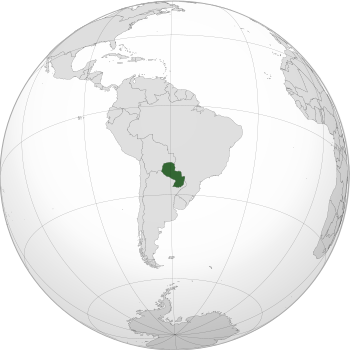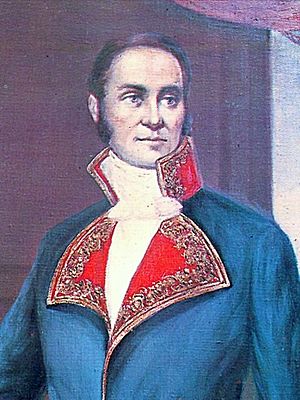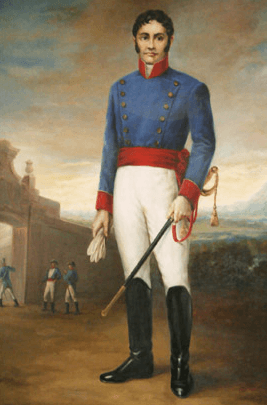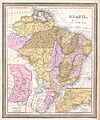Independence of Paraguay facts for kids
Quick facts for kids
Republic of Paraguay
República del Paraguay
|
|||||||||
|---|---|---|---|---|---|---|---|---|---|
| 1811–1814 | |||||||||
 |
|||||||||
| Capital | Asunción | ||||||||
| President | |||||||||
|
• 1811-1813
|
Fulgencio Yegros | ||||||||
| Governor Intendants | |||||||||
|
• 1811
|
Bernardo de Velasco | ||||||||
|
• 1811
|
Rodríguez de Francia | ||||||||
|
• 1811
|
Valeriano de Zevallos | ||||||||
| Consul | |||||||||
|
• 1813-1814
|
Rodríguez de Francia | ||||||||
|
• 1814
|
Fulgencio Yegros | ||||||||
| Historical era | Decolonization of the Americas | ||||||||
| 25 May 1810 | |||||||||
|
• Established
|
14 May 1811 | ||||||||
|
• Republic proclaimed
|
12 October 1813 | ||||||||
|
• Disestablished
|
3 October 1814 | ||||||||
|
|||||||||
The independence of Paraguay began on May 14, 1811. This was when a local ruling group, called a junta, was formed. Before this, in early 1811, Paraguayan forces had beaten the Argentine army several times. Argentina saw Paraguay as a part of its own territory.
On October 12, 1813, the Republic of Paraguay was officially announced. However, full independence was only declared on November 25, 1842. Paraguay's independence was truly safe after the Paraguayan War. During this war, the Empire of Brazil stopped Argentina from trying to divide and take over Paraguay.
Contents
How Paraguay Became Independent
The Spanish Empire's Rule
In 1776, the Spanish king Carlos III created a large area called the Viceroyalty of the Río de la Plata. Its capital city was Buenos Aires. This area included parts of what are now Argentina, Bolivia, Uruguay, and a Brazilian state called Rio Grande do Sul.
Later, in 1782, a system of local governments was set up. The area of Paraguay had only one city with official city status: Asunción.
During the time of Napoleon Bonaparte and the Peninsular War, Spain was first allied with, then taken over by, France. At this time, the British Empire tried to take control of the Viceroyalty. They launched the British invasions of the River Plate, occupying Buenos Aires in 1806 and 1807. Paraguayan soldiers, led by Governor Bernardo de Velasco, fought in battles for Montevideo during these invasions.
Royalist Control and Early Rebellions
After the May Revolution in Buenos Aires in 1810, a new ruling group called the Primera Junta was formed. This group wanted to rule the entire former viceroyalty. They sent Colonel José de Espinola to Asunción to bring Paraguay under their control. But Espinola failed and was quickly forced out of the province.
The Spanish governor of Asunción, Bernardo de Velasco, gathered a local council (Cabildo) of 200 important people on July 24. They sent a message to Buenos Aires. It said they would remain loyal to the Spanish king Ferdinand VII and would not accept the Primera Junta's authority. The local council also announced that soldiers would be prepared. Velasco then left with troops to Yaguarón to set up defenses.
Paraguay's future was shaped by conflicts between three main groups:
- The gachupines: People born in Spain.
- The porteños: People from Buenos Aires.
- The criollo elite: Local leaders born in Paraguay. This group was led by Fulgencio Yegros and Pedro Juan Caballero.
In September 1810, a plan by porteños to take power in Asunción was discovered. The people involved were arrested and sent to Fort Borbon.
The porteños wanted to rule the entire former viceroyalty. So, in September 1810, Buenos Aires sent troops under General Manuel Belgrano to conquer Paraguay. But in early 1811, Belgrano's forces were defeated. They lost battles at battle of Tacuarí and battle of Paraguarí. The Paraguay campaign ended in failure for Buenos Aires.
Governor Velasco had shown fear by running away from these battles. He then planned to ask Portugal for military help and was ready to accept Portuguese rule. This made the victorious criollo Paraguayan soldiers unhappy. The Portuguese were old enemies who had taken many Paraguayan lands.
The criollo army's two victories over Belgrano made the royalists and Governor Velasco weaker. It also made the local criollo officers feel more patriotic. They began to plan to overthrow Velasco.
The May 14 Revolution
The original plan was for a military uprising on May 25. This was the one-year anniversary of the May Revolution. Soldiers led by Fulgencio Yegros were supposed to march from Itapúa. Other towns' soldiers would support them. However, Governor Velasco's talks with Portuguese representatives from Brazil sped up the uprising.
On the evening of May 14, 1811, a military revolt began in the Asunción army base. The plotters, led by Captain Pedro Juan Caballero, went to the Governor's house. It was located on the main square of Asunción. They were met by Second Lieutenant Mauricio José Troche. He was a supporter of the plan and was in charge of the small group of 34 soldiers from Curuguaty.
At midnight, Ensign Vicente Ignacio Iturbe went to Governor Velasco. He presented demands from the plotters, led by Caballero. These demands were:
- "Give up control of the main square, all weapons, and the keys to the Cabildo (city council building)."
- "Governor Velasco can stay in power. But he must be part of a three-person ruling group. This group should include two representatives chosen by the officers."
A group of officers and politicians forced Governor Velasco to agree. This group included Captain Pedro Juan Caballero, Fulgencio Yegros, Vicente Ignacio Iturbe, Mauricio Jose Troche, Fernando de la Mora, Juan Valeriano de Zeballos, and José Gaspar Rodríguez de Francia. They insisted on creating a three-person executive group.
Governor Bernardo de Velasco did not want to accept the plotters' demands. So, more revolutionary soldiers came to the square. They set up eight cannons in front of the government house in Asunción. Ensign Vicente Ignacio Iturbe brought a new, urgent message, giving a short time for a response. It was already early morning on May 15, 1811. As the town's soldiers gathered, Governor Velasco did not want any fighting. He came to the door and said: "If this is about authority, I give up the command baton." The crowd cheered. The flag was raised, and a 21-gun salute was fired. Church bells rang (this day is now celebrated as Paraguayan Independence Day).
On May 17, a public announcement told the people that a new ruling group had been created. It included Governor Velasco, Gaspar Rodriguez de Francia, and Spanish-born Army Captain Juan Valeriano de Zeballos. Fulgencio Yegros arrived in Asunción on May 21, 1811.
Steps Towards Full Independence
The ruling group, or Junta, included Governor Velasco, local politician Francia, and Spanish officer Zeballos. They still swore loyalty to the Spanish crown. This group ruled until the First National Congress met on June 17, 1811. Even before the Congress, Velasco was placed under house arrest on June 9. This was because he continued to secretly work with the Portuguese (conspiring with the Portuguese).
The Congress approved a new five-person ruling group called the Junta Superior Gubernativa. Fulgencio Yegros led this group. On July 20, 1811, the Junta sent a letter to Buenos Aires. It stated Paraguay's desire to be independent. It also suggested forming a group of independent countries. On October 12, 1811, a short-term agreement for a confederation was signed with Buenos Aires.
The Second National Congress was held from September 30 to October 12, 1813. About 1,100 representatives attended. Pedro Juan Caballero led the meeting. The Congress approved a new Constitution on October 12, 1813. On this day, the Paraguayan Republic was officially announced. The Congress also created a two-person executive body with two leaders, called Consuls: Yegros and Francia. The Third National Congress took place on October 3-4, 1814. It replaced the two-person leadership with a single ruler. Francia was chosen for this role.
International Recognition of Paraguay
Paraguay managed to stay separate from the outside world under Francia's rule. It avoided wars with the Argentine Confederation and the Empire of Brazil. However, its independence was still not recognized by other countries.
On November 25, 1842, the Paraguayan Congress formally declared an Act of Independence. Bolivia recognized Paraguay's independence on June 17, 1843. But it was truly secure only after the Empire of Brazil recognized it on September 14, 1844. Argentina followed on July 17, 1852. However, Argentina's Congress rejected this recognition. So, Argentina's actual recognition of independence came only in 1856.
The United States recognized Paraguay as a separate and independent country on April 27, 1852. The American Legation (a type of embassy) in Asunción was opened on November 26, 1861. This was when American Commissioner Charles A. Washburn presented his official papers.
Images for kids
See also
 In Spanish: Independencia del Paraguay para niños
In Spanish: Independencia del Paraguay para niños






